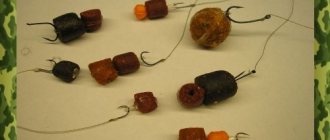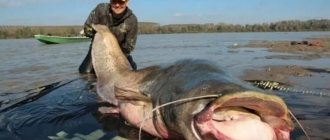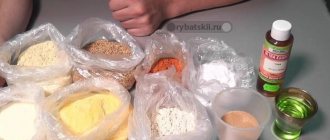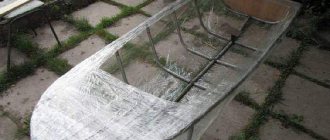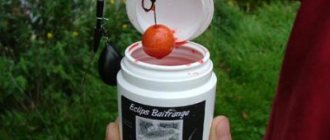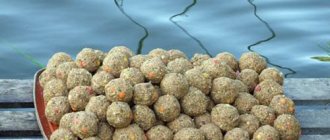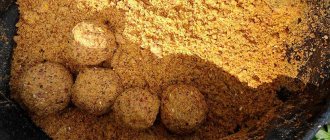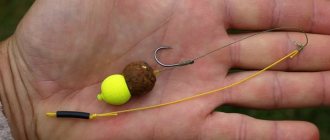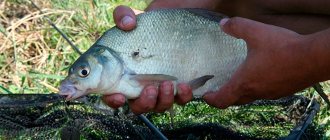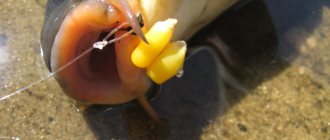What it is?
The word "dip", like many other fishing terms, came to us from the English language. The term “dip” translated into Russian means to dip. This is exactly what happens to the bait during fishing; it is dipped into a liquid or powdery flavoring. It should be noted that some formulations are available in the form of sprays, which are used to spray the bait before casting.
Due to the fact that the dip has a sharper smell, which also differs from the aroma of bait, it is easier for the underwater inhabitant to find a tasty morsel, which means that the bite will occur in a shorter period of time after casting.
Attention! Baits used for catching peaceful fish are subjected to deepening. Dipping wobblers or spinners into the aromatic liquid is not recommended.
Classification
Dips are divided according to two main criteria:
- duration of action;
- according to composition and manufacturing method.
By duration of action
First, it should be noted that dips are not only flavoring agents, but also a kind of preservative that prevents the bait from premature deterioration.
So, the first type of dips can be called fast-acting based on this criterion. Their main task is to give a signal to the fish: there is a “yummy” here! The bait is dipped into this composition for a short time, only to create a surface layer. By the way, dips in the form of sprays are an excellent example of this. The second type of dip is long-lasting or nutritious. In such compositions, bait, for example, boilies or corn grains, can be placed on the eve of fishing, or, in general, stored in an aromatic liquid.
Boilies placed in a flavoring solution remain fresh and ready for fishing for a long time
Due to the stabilizers and preservatives contained in the second type of dips, the baits dipped into them remain fresh longer. On the contrary, many argue that long exposure improves the quality of the bait.
Another advantage of nutritional dips is the fact that fish become more quickly saturated with them. This is achieved through the use of protein in formulations.
Attention! Baits prepared in this way work well at any water temperature and emit aromas that are attractive to fish longer.
By cooking method
Dips are prepared on different bases. Due to this, the direction of their application also changes.
Oily
The simplest form is oil. As the name implies, the basis of preparation is oil, most often refined sunflower oil, to which some flavorings are added.
They usually act for a short time and are applied immediately before casting.
It is never clear what smell will attract fish today, so a real fisherman should have as wide a choice of dips as possible
Sticky
Sticky dip is essentially flavored glue. Before use, the mixture should be warmed up and then applied to the bait.
The sticky shell gradually dissolves in water, attracting fish with the aroma released. This composition is neither nutritional nor preservative, but is used directly on the day of fishing.
On a note! After applying the sticky dip, you can add any dry additives on top of it: ground seeds, pieces of fruit, etc.
Powder
It is used in almost the same way as glue dip, except that the bait is dipped not in a sticky mass, but in a fragrant powder. Before dipping, and in some cases after it, the bait should be soaked in water.
Powder dip is applied to the pre-wetted surface of the bait, for example, a carp boilie
Gel (neon)
This type of dip is based on a gel-like substance. Due to the fact that it glows under water, this liquid flavor is also called neon.
These dips have a stable odor and fairly good preservation: the color and aroma last for several hours. Products are available for both night and day fishing.
Dips
- VK
So - deep, what is it? In English, the word dip has many different meanings, but in our case the most suitable are: immersion, dipping, deepening - since these are the ones that describe the way they are used.
When, in the process of experimenting with boilie compositions, it became clear that carp are very partial to various odors, a wide field for creativity opened up for anglers in the field of improving the attractiveness of baits. Having tried a wide variety of, and sometimes simply incredible, odors, tireless experimenters moved from quantity to quality, that is, to determining the optimal concentration of a particular aroma in the bait. One way or another, the appearance of dips was predetermined: it was necessary to find a product that could complement the boilies with an aroma that was attractive to fish and optimal in terms of intensity, or even completely change the smell that the bait already had.
At first glance, it may seem that nothing is simpler - you just need to dip the bait in a liquid with a suitable aroma. For example, into concentrated attractants, which theoretically appeal to carp. However, in this understanding of the solution to the problem lies a mistake, which is the cause of many fishing failures.
The fact is that, compared to the human nose, the carp’s olfactory organ is a device hundreds of times more sensitive, and therefore the use of pure aroma does not work in the best way, and sometimes it simply scares away the fish. The result is that hours and days pass while waiting for a bite, and only because the aroma must “dissipate” before the fish can approach your bait.
Modern dips are less concentrated than pure flavoring (its component in the dip ranges from 10-25%). Therefore, their effectiveness lies precisely in the fact that they increase the level of odor without crossing the line that is unpleasant for the carp.
Today, dips have evolved from a simple flavored “gravy” to complex “potions” containing flavoring additives, amino acids, appetite stimulants, various enhancers of God knows what, and much more.
But the main idea of using dips remains the same - they serve to flavor carp (and not only) baits, distinguishing them from the background of bait material. Most often these are boilies, although any bait of plant origin can be “dipped”. Moreover, you usually need to keep corn or peas in the dip much less than boilies.
The most important advantage of dips is that they allow you to change the smell of the bait.
For example, in a situation where fish are attracted to baits with only one specific scent, and you don’t have boilies with that particular scent. But there is a dip, and it can help, you just need to remember that for this you still need to take boilies that are similar in smell to the chosen dip. You also need to remember that soaking boilies with a strong aroma in the dip will subsequently lead to a change in the smell of the dip itself.
In this regard, a little advice: when going fishing in an unknown body of water, it’s a good idea to prepare some odorless boilies at home in advance and take different dips with you - this will allow you to adapt to any situation and increase the life of the dips.
There are two reasons why dips lose their properties. Firstly, the smell evaporates and is transferred to boilies or other baits, and secondly, aromatic substances are still subject to decomposition over time, and gradually there comes a time when the smell of the dip ceases to be clearly pronounced and intense. This means only one thing - it’s time to change the dip - when fishing there is no time for half measures!
At the same time, this does not mean that the old dip needs to be thrown away - it can be successfully used to flavor dry bait by adding it to the water in which the bait will be mixed. The period of full operation of the dip depends on the intensity of use and the time during which the dip stood on the store shelf. It can be assumed that a dip from a well-known manufacturer should withstand at least one season, and if it is stored under normal conditions, that is, in a dark and cool place, then it will work for two or three seasons without any problems.
Deeps also have properties that I would call functional. One of them is that most dips significantly increase the hardness of the boilie. This, in my opinion, is one of the most important properties, which, however, often goes unnoticed by carp anglers. In my opinion, there is no better weapon against crayfish than boilies kept in dip for several weeks, or even months. Such boilies can withstand many hours of “treatment” with crayfish claws. The fight against tangling of leashes in this case is a topic for a separate discussion. There is only one caveat: if you decide to use this method, do not forget to drill them in advance before immersing the boilies in the dip, otherwise you will have the same problems as the crayfish.
Please also keep in mind that floating boilies may partially or even completely lose their buoyancy after being in the dip for a very long time. Another very important property of dips is their ability to slow down the process of deterioration of boilies, even those made without the use of preservatives. Most dips basically contain various alcohol solutions, which stop the rotting process. True, there are oil-based dips, but these types of products are less common.
Recently, a new generation of dips has appeared on the market, in which the base itself is a delicacy for carp, as it includes various stimulants, enhancers and amino acids. These products, in addition to their classic purpose, also serve as appetite stimulants. Different manufacturers call such dips food dip, enhancing system, energy dip (which translated from English means: nutritional dip, enhancing system, energy dip).
Another advantage of such dips is that most of them do not dissolve PVA. Fishermen who use products made from this material will undoubtedly appreciate this property. So we can safely say that these dips are real “carp killers”!
Classic liquid dips have one, one might say, utilitarian drawback - they spill out due to carelessness. But there are dips that do not have this drawback - in powder form, for example. They consist of powdered attractants, a gelling agent and, depending on the manufacturer, flavoring agents. Some companies also add flavor enhancers to them.
The method of using powder dips is somewhat different from the method of using liquid dips. Bait (for example, boilies or corn) must first be soaked in water and then rolled in powder. When interacting with water, the powder turns into jelly, which is absorbed into the bait.
When dry, the outer layer turns into a hard crust, which, dissolving in water, creates a fragrant cloud around the bait. To obtain a thicker coating layer, the procedure can be repeated. You can process boilies in this way at home, then on the shore all that remains is to fix the dry bait on a hair and throw it to the fishing spot.
The powdered dip, of course, does not spill out, but it can spill out, which means, again, if handled carelessly, losses are quite possible. Another product - gels for dipping baits - practically does not have this drawback. The consistency of the gels is such that they do not spill immediately, even if the container with them is turned upside down. I think there is no need to explain how to use them, as for the composition - it is the same as that of other dips.
As you can see, different types of dips allow you to adapt to any fishing conditions and ultimately fulfill their intended purpose - to make the bait more attractive.
All that remains is to answer the question: when and where to use them?
The answer may be this: first of all, when fishing in places where carp need to “find” the bait - with a strong own smell, in silted areas or with abundant vegetation.
Dips are also extremely effective when fishing in currents. In general, anglers everywhere in the world always use them. And this, of course, is justified, since in most reservoirs, especially near large cities, there is strong fishing pressure, and in order to outwit the carp, you need to be very well equipped.
But there are situations in which dips should not be used or it is necessary to greatly reduce the time the bait is in the dip, to the point of limiting it to a one-time immersion of the bait. This approach is justified in wild bodies of water, where fishermen are a rare visitor (really, where can we find one like this?). In such places, dip, which gives a powerful impulse of an unusual odor, can lead to increased caution of distrustful carp or even scare them away from the feeding area for some time.
There was also a dependence on the time of year. In early spring, the best effect is produced by boilies that have been in the dip for a short time (a day or two), but in summer and autumn - with a stronger odor (even those that have been in the dip since spring). A good effect on hot days, when it seems that “everything in the water has died,” is achieved by adding a little vodka to the dip (25-30%). Sometimes the result is very impressive, probably due to the fact that the speed of propagation of the aromatic impulse increases significantly, and at the same time the intensity of attachment also increases. This method of diluting the dip with vodka can be successfully used in the cold season.
Another question: which scent should I choose?
Of course, there is no clear answer to this. Every angler who uses dips has their own favorite scents, so it’s difficult to recommend anything specific in this regard. Only one thing can be said for sure: the effectiveness of certain aromas depends on the time of year and the specific body of water.
The history of dips goes back a good few decades (spray for flavoring predator baits doesn’t count, and it’s only a stretch to call it a dip), and the English company Mistral was the first to offer them to anglers.
It's rare for a new product to become popular right away, but dips were an exception and were an instant hit on the market as they were really good at attracting carp. Soon their production and sales were included in the programs of many respected and self-respecting companies. Naturally, like most carp baits from different manufacturers, all dips are similar to each other and do not differ radically in proportions. So all you have to do is choose a product from a company that you trust or whose products you can afford.
Related articles:
Equipment with a movable boilie Pop-Up
Carp leashes
Installing a boilie on a hook
Fishing for large carp
Principles of making at home
DIY fishing dips can be made on one of two bases:
- in sugar syrup;
- nutritional fluid.
At the final stage, a selected concentrated flavor is added to any of these compositions.
Attention! Sugar syrup is prepared at the rate of a kilogram of sugar per 750 milliliters of warm water.
Don't be intimidated by the word "nutritive." In fact, annual formulations are easy to purchase in specialized stores, and flavoring can be carried out directly in your kitchen. As a result, you will get that “long-lasting” dip.
The following is used as a basis for such dips:
- natural proteins;
- molasses and other beet and corn products, such as CSL liqueurs;
- appetite stimulants;
- liquid liver;
- yeast.
When making aromatic liquids, use only clean containers
Payment Methods
Cash payment
You can pay in cash in store
, as well as
upon receipt of the order from the courier
.
Cashless payments
You can pay for goods by credit card when purchasing online and/or in a physical store. You can also send payment for your order to our bank account using the details below.
Attention!!!
After payment, please send a check indicating your full name and order number to our manager: [email protected] .
Card of the company "Savai" LLC ("Savai" store)
Legal address
: 119634, Moscow,
Sholokhova property 2a
Fact. address
: 119634, Moscow,
st. Sholokhova, vl. 2A Calc. account 40702810938000190801 PJSC SBERBANK
, Moscow
Cor. account 30101.810.4.00000000225
,
BIC 044525225 INN 9729203661
;
Checkpoint 772901001
Here you can receive payment receipts for your order at the Savay store: Receipt form for payment for your order at the Savay store.
Attention!
Your
payment
may take
up to 3 business days
. We will ship the order within 1-2 days from receipt of payment.
Recipes
There are many recipes for fishing dips on the Internet. We have selected the best of them, and will also share a couple of original compositions from the author of the article.
Carp based on CSL
This recipe is good for use in carp fishing in cold water, when fish and meat smells are in use. The composition of the dip is as follows:
- nutritional liquid CSL – 100 milliliters;
- liquid liver – 50 ml;
- fish protein L-030 – 100 ml.
The ingredients are first mixed, then the selected flavors are added to the resulting composition. It is advisable to use meat, fish attractants or some kind of spice, such as garlic, for example.
Attention! It is best to soak boilies made on the basis of fishmeal with this dip.
Carp sweet
Sweet dips for carp are prepared, naturally, based on sugar syrup. The recipe includes:
- water – 750 grams;
- sugar – 1 kilogram;
- vanilla pods – 4 pieces;
- or vanilla sugar - 1 packet.
The cooking process is brilliantly simple:
- Boil water.
- Gradually add sugar until it is completely dissolved.
- Add vanilla, stirring constantly. Boil until cooked: completely dissolved.
- Without cooling, strain the liquid.
The finished dip does not need to be flavored; it will attract fish not only with its smell, but also with its sweet taste. Prepared boilies can be placed in this syrup in advance and kept in it for a long time. When the syrup hardens or becomes sugary, it should be reheated.
Properly prepared dip will help carp find your bait faster
Protein-based bream
Although this dip option is originally intended for bream, it seems to us that it will work well for other carp fish:
- roach;
- carp;
- crucian carp;
- white-eye;
- silver bream
To make the dip you need to purchase and add to the composition:
- natural protein Minamino – 100 ml;
- nutritional liquid CSL – 100 ml;
- liquid yeast – 50 ml.
The ingredients should be thoroughly mixed and the dip is ready to use.
The dip suggested in the recipe does not need to be additionally flavored, since the protein contains a raspberry attractant
Spicy bream
This option is prepared based on the sugar syrup described above, excluding the addition of vanilla. Instead, the composition is flavored with the following spices:
- ground coriander – 2 teaspoons;
- cinnamon – 2 teaspoons;
- clove buds - 16 pieces;
- lemon juice – 8 teaspoons.
The listed spices are added to the syrup at the boiling stage of water and thoroughly boiled. After which the syrup should be filtered so that the solution is free of impurities. It is best to use the dip in cool water when the fish is preparing for winter.
You can even dip animal bait, such as maggots, into the spicy dip
Honey Syncronic
How to make your own boilies at home (recipes)
This recipe is very popular among “advanced” feeder fishing masters. Don't believe me? Then cook and try it yourself.
To make it you will need:
- liquid honey – 2 tablespoons;
- glycerin – 40 milliliters;
- icing sugar or powdered sugar – 50 grams;
- red food coloring – 30 milligrams;
- almond flavoring – 30 milliliters.
Prepare in the following order:
- First, mix all the additives except the honey base.
- Warm up the honey a little; if it is sugared, melt it.
- Combine the spices with honey and mix everything thoroughly.
The resulting composition perfectly impregnates boilies and acts under water for a long time.
Garlic sweet
It is no secret that many carp fish are very partial to the smell of garlic, especially for such a fastidious inhabitant of our ponds, crucian carp. The hot vegetable dip is prepared using sugar syrup, which reliably retains the smell.
Compound:
- water – 50 milliliters;
- sugar – 100 grams;
- garlic – 3 medium cloves.
Prepare in the following order:
- Grate the garlic on a fine grater.
- Pour sugar into water and put on fire.
- Bring to a boil.
- Once the syrup begins to thicken, remove from the stove.
- Add grated garlic to it and mix thoroughly.
- Strain the cooled syrup through cheesecloth.
Attention! If there are still notes of bitterness in the prepared dip, you should add sugar and boil again.
Garlic from the author
This garlic recipe is very simple, but effective for crucian carp, roach, and bream. It is prepared on the basis of unrefined, fragrant oil. In this case, we get two odors that are attractive to white fish at once.
Garlic for flavoring must be fresh with a pronounced odor
The cooking procedure is as follows:
- Pour fifty grams of unrefined oil into a clean bowl. It is best if it is directly pressed farm oil, but in a pinch, store-bought oil will do.
- Grate the garlic on a fine grater or pass it through a garlic press.
- Place the garlic in a container with oil and mix thoroughly.
- Let the mixture sit, the signal for readiness will be a softening of the pungent garlic smell.
You can dip not only plant baits into this dip, but also a worm with maggots. Garlic especially affects the worm; it begins to squirm feverishly, and yellow discharge appears on its body.
Attention! The worm should be dipped in garlic dip immediately before casting. Staying in this liquid for a long time will lead to his death.
Chocolate
Carps and carp are known to have a sweet tooth, so they will not refuse chocolate in the summer. The dip is prepared on the basis of the sugar syrup we already know, per liter of which you need to take 150 grams of chocolate.
Add grated chocolate or, alternatively, cocoa powder to the finished syrup. Then bring the liquid to a boil and cook until all particles are completely dissolved.
Pour the composition into clean jars and let it brew in a cool place for at least 24 hours.
